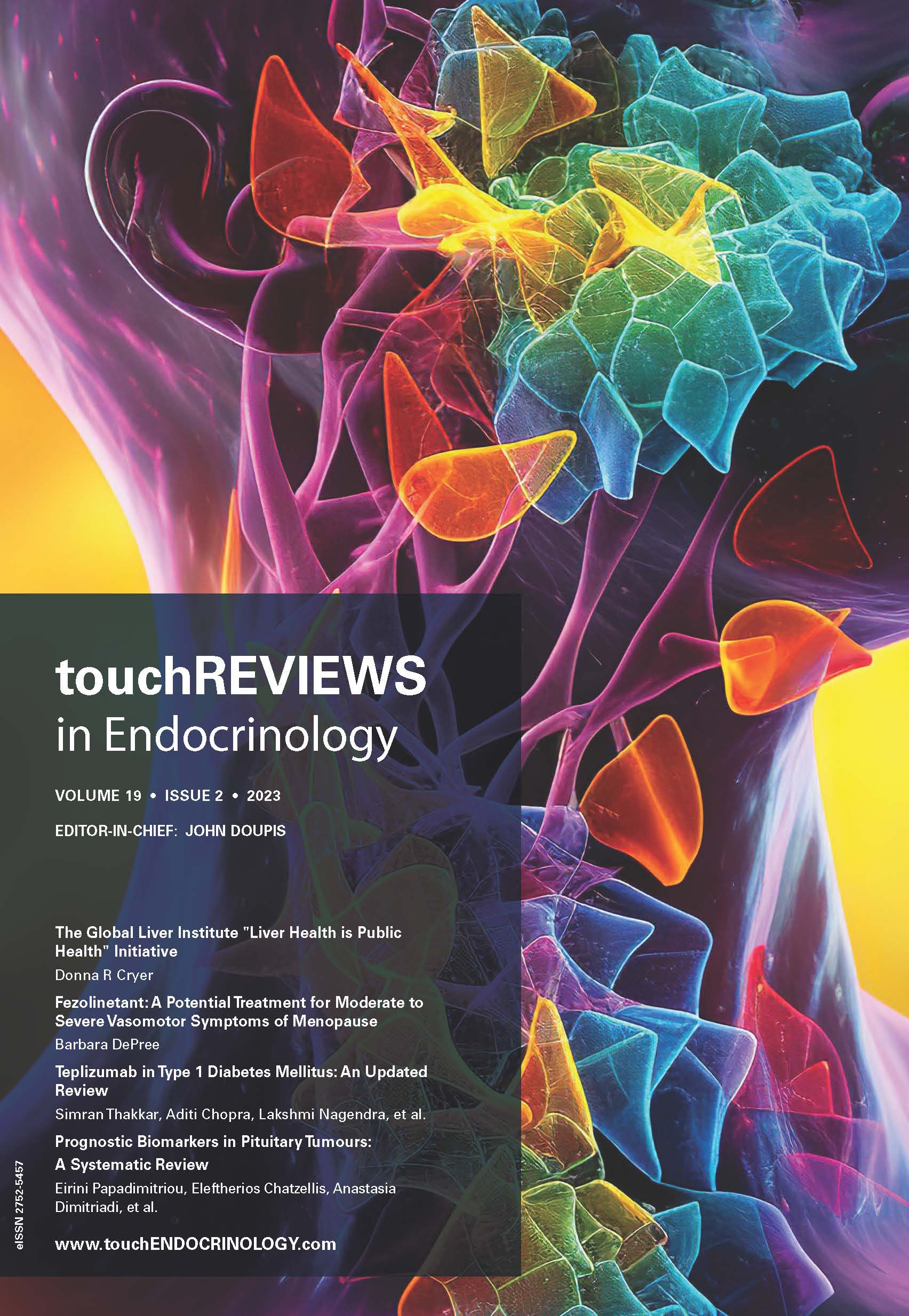European Endocrinology 16.2 – Autumn 2020
Welcome to the autumn edition of European Endocrinology!
Introduced by our Editor-in-Chief, John Doupis, this issue features free-to-access editorials, reviews, original research articles and case reports across a wide range of clinically relevant topics relating to cardiovascular risk, COVID-19, diabetes, endocrine oncology, obesity, reproductive endocrinology and thyroid disorders.
We trust you’ll find something that is of interest with respect to your own daily clinical practice. As always, we thank all authors who contributed expertise to this exciting edition, and the Editorial Board for their continued support and guidance.
We are now welcoming submissions to our 2021 editions. If you’re interested in submitting an article, please don’t hesitate to contact us directly.
Foreword
Welcome to the latest edition of European Endocrinology. The impacts of the COVID-19 pandemic are being felt throughout the biomedical community, and the association between diabetes and poor prognosis in COVID-19 is of particular interest to endocrinologists. We begin with an editorial by myself and Avramidis, which provides advice on the management of patients with […]
Editorials
The coronavirus disease 2019 (COVID-19) pandemic is an occurring global public health crisis due to the spread of the severe acute respiratory syndrome coronavirus 2 (SARS-CoV-2).1 In December of 2019, a low respiratory tract infection of unknown cause emerged in Wuhan, Hubei Province, China. The Huanan seafood market was considered to be the main source of […]
The role of testosterone is well established in health and disease.1 Testosterone is known to mediate physical, mental and reproductive health. Its role has been discussed in gender-specific variations related to conditions as diverse as cardiovascular, autoimmune, psychiatric and oncological diseases.2–4 The recent coronavirus disease 2019 (COVID-19) pandemic has uncovered newer facets of testosterone action and […]
Commentary
Neuroendocrine tumours (NETs) represent a heterogeneous group of neoplasms arising from the neuroendocrine cell system, primarily in the gastrointestinal or bronchial tracts. Well-differentiated, low-grade NETs (G1/G2) are often indolent in their behaviour; they may present with a lack of initial symptomatology, and can grow slowly. As a consequence, many cases are diagnosed at advanced stages, […]
Reviews
Takotsubo cardiomyopathy (TCMP), also known as ‘broken heart syndrome’ or ‘stress cardiomyopathy’, is a well-characterised condition. It presents in the acute phase with clinical, biochemical and electrocardiographic features similar to acute myocardial infarction. However, on performing an angiogram, the patient is found to have no coronary artery involvement. ‘Takotsubo’ is a Japanese word for an […]
The coronavirus disease 2019 (COVID-19) pandemic has spread rapidly to become a global health threat. The disease is caused by severe acute respiratory syndrome coronavirus-2 (SARS-CoV-2), a novel β-coronavirus that belongs to a family of enveloped RNA viruses, the coronaviruses.1 While some of the coronaviruses cause common flu, other strains, such as SARS-CoV, Middle East respiratory syndrome […]
Hydroxychloroquine has been in clinical use for decades, being extensively used by rheumatologists across the globe for different autoimmune disorders (rheumatoid arthritis, lupus and Sjögren‘s syndrome, among others), across all age groups and including during pregnancy. Novel coronavirus disease (COVID-19), caused by infection with severe acute respiratory syndrome coronavirus 2 (SARS-CoV-2) is a pandemic sweeping […]
The International Diabetes Federation (IDF) estimates that 463 million people worldwide suffer from diabetes, 90% of whom have type 2 diabetes mellitus (T2DM), and expects the total healthcare expenditure on diabetes to reach US$ 845 billion by 2045 from US$ 760 billion in 2019.1 People with diabetes comprise 9.3% of the world’s adult population, and the […]
Recent advances have bolstered the anticancer therapeutic armamentarium. However, despite the enhanced efficacy and better survival offered by these newer agents, side effects remain a source of concern.1 Gastrointestinal side effects, organ toxicities and dyselectrolytaemias are critical adverse consequences. Among these, dyselectrolytaemias are multifactorial and need to be monitored and managed appropriately.1 In this review, we aim […]
Colloid goitre is defined as thyroid enlargement without accompanying disturbance in thyroid function. This is a common pathology, frequently found in clinical practice during a physical or ultrasound examination. Colloid goitre has been classified as nontoxic goitre according to the updated International Classification of Diseases (Table 1).1 Colloid goitre is also known as endemic goitre, simple […]
Original Research
Statin-associated muscle symptoms (SAMS) may lead to medication non-adherence among statin users. SAMS include myalgia, myositis and rhabdomyolysis (rarely seen).1 According to a recent study conducted in India, about 22% of statin users are affected by SAMS.2 Many studies have been conducted to establish a correlation between SAMS and levels of vitamin D and creatine phosphokinase (CPK; […]
The management of type 2 diabetes mellitus (T2DM) involves multifactorial strategies that include diet management, exercise, glucose monitoring, anti-obesity measures, intake of oral antihyperglycaemic agents and, in some cases, insulin administration. Despite the use of multiple oral antihyperglycaemic drugs at maximum dose, some patients are unable to maintain glycaemic control and are recommended to initiate […]
The prevalence of obesity has increased exponentially across the world, nearly doubling in the span of a decade.1 This is primarily attributed to lifestyle shifts, including diets dominated by hydrogenated fat and animal products, carbohydrate excess and increasingly sedentary lifestyles. The impact of these trends is magnified in developing countries as the resources available to […]
The prevalence of obesity is rapidly increasing across the world. In India, about 12.6% women and 9.3% men are obese, amounting to more than a 100 million population.1 Obesity, which was earlier considered to be a growing problem only in metropolitan cities, is now noted to be just as prevalent in smaller semi-urban towns.2 It is not […]
Polycystic ovary syndrome (PCOS), the most common endocrine disorder in women of reproductive age, is a heterogeneous androgen-excess disorder with different degrees of reproductive and metabolic dysfunctions.1 Thyroid disorders are also quite common and are among the most common endocrine disorders worldwide.2,3 Subclinical hypothyroidism (SCH) is defined as an elevation of serum thyroid-stimulating hormone (TSH) levels beyond […]
The estimation of lipid parameters has traditionally been carried out in the fasting state, without definitive evidence to suggest that this is superior to assessing them in the post-prandial period in terms of predicting metabolic outcomes and cardiovascular risk.1 Post-prandial lipoprotein metabolism is believed to play a role in the development of atherosclerosis.2 Post-prandial dyslipidaemia may be […]
Case Reports
Insulin autoimmune syndrome (IAS) is a leading cause of hypoglycaemia in the Japanese population.1 In India, which has a population of more than 1 billion, only 28 cases of IAS have been reported to date, to the best of our knowledge.2–10 IAS is characterised by hyperinsulinaemic hypoglycaemia – elevated insulin autoantibody titres with no prior exposure to […]
Adrenocortical carcinoma (ACC) is a rare malignancy, and presentation as bilateral adrenal masses and acute adrenal insufficiency is even rarer. Due to the relative commonality of other causes for bilateral adrenal masses, such as metastases or infiltrative diseases, they take precedence while considering differential diagnoses. We present the case of a gentleman who presented with […]

Trending Topic
Thyroid nodules are common worldwide, and their prevalence is increasing. Most nodules are asymptomatic and detected incidentally on cross-sectional imaging or physical examination. In rare cases (10–15%), nodules are malignant and require diagnostic evaluation. Even malignant nodules frequently show non-aggressive behaviour.1 The increase in the incidence of thyroid cancer is unfairly distributed globally, and the […]
Journal Archive
touchREVIEWS in Endocrinology (previously European Endocrinology) is a peer-reviewed, free-to-access, bi-annual journal comprising review articles, case reports, editorials, special reports and original research. It features balanced and comprehensive articles written by leading authorities, addressing the most important and salient developments in the field of endocrinology.
Latest articles videos and clinical updates - straight to your inbox
Log into your Touch Account
Earn and track your CME credits on the go, save articles for later, and follow the latest congress coverage.
Register now for FREE Access
Register for free to hear about the latest expert-led education, peer-reviewed articles, conference highlights, and innovative CME activities.
Sign up with an Email
Or use a Social Account.
This Functionality is for
Members Only
Explore the latest in medical education and stay current in your field. Create a free account to track your learning.
























